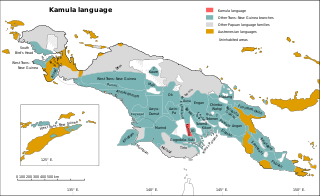The Busa language, also known as Odiai (Uriai), is spoken in three hamlets of northwestern Papua New Guinea. There were 244 speakers at the time of the 2000 census. One of the hamlets where Busa is spoken is Busa in Rawei ward, Green River Rural LLG, Sandaun Province.
Sulka is a language isolate of New Britain, Papua New Guinea. In 1991, there were 2,500 speakers in eastern Pomio District, East New Britain Province. Villages include Guma in East Pomio Rural LLG. With such a low population of speakers, this language is considered to be endangered. Sulka speakers had originally migrated to East New Britain from New Ireland.
The Kuot language, or Panaras, is a language isolate, the only non-Austronesian language spoken on the island of New Ireland, Papua New Guinea. Lindström estimates that there are 1,500 fluent speakers of Kuot. Perhaps due to the small speaker base, there are no significant dialects present within Kuot. It is spoken in 10 villages, including Panaras village of Sentral Niu Ailan Rural LLG in New Ireland Province.
The Ata language, also known as Pele-Ata after its two dialects, or Wasi, is a Papuan language spoken on New Britain island, Papua New Guinea. It appears to be related to neighboring Anêm, and possibly also to Yélî Dnye in a proposed Yele-West New Britain family. There are about 2000 speakers.

Abom is a nearly extinct language spoken in the Western Province of Papua New Guinea. According to a 2002 census, only 15 people still speak this language. All of the speakers are older adults. Middle-aged adults have some understanding of it, but no children speak or understand Abom.

Papua New Guinea, a sovereign state in Oceania, is the most linguistically diverse country in the world. According to Ethnologue, there are 840 living languages spoken in the country. In 2006, Papua New Guinea Prime Minister Sir Michael Somare stated that "Papua New Guinea has 832 living languages ." Languages with statutory recognition are Tok Pisin, English, Hiri Motu, and Papua New Guinean Sign Language. Tok Pisin, an English-based creole, is the most widely spoken, serving as the country's lingua franca. Papua New Guinean Sign Language became the fourth officially recognised language in May 2015, and is used by the deaf population throughout the country.

Kamula is a Trans–New Guinea language that is unclassified within that family in the classification of Malcolm Ross (2005). Noting insufficient evidence, Pawley and Hammarström (2018) leave it as unclassified.
Mali or Gaktai is a Papuan language spoken in East New Britain Province on the island of New Britain, Papua New Guinea.
Kairak is a Papuan language spoken in East New Britain Province on the island of New Britain, Papua New Guinea. It is spoken in Ivere and Malabunga villages of Inland Baining Rural LLG.
The Waruna language is a Papuan language of the New Guinea, spoken in a bend of the Fly River. It has 50% lexical similarity with Ari, its closest relative. It is spoken in the single village of Waruna in Gogodala Rural LLG.
Dibiyasoa.k.a.Bainapi is a Papuan language of Western Province, Papua New Guinea.
Ainbai is a Papuan language of Sandaun Province, Papua New Guinea. It is spoken in Ainbai village, Bewani/Wutung Onei Rural LLG, Sandaun Province.
The Taulil–Butam or Butam–Taulil languages are a small language family spoken in East New Britain Province, Papua New Guinea. They may be related to the Baining languages. Speakers consistently report that their ancestors came from New Ireland.
West Kikori Rural LLG is a local-level government (LLG) of Gulf Province, Papua New Guinea. Kiwaian languages are spoken in the LLG.

Kiwai Rural LLG is a local-level government (LLG) of Western Province, Papua New Guinea. Kiwaian languages are spoken in the LLG.
Marienberg Rural LLG is a local-level government (LLG) of East Sepik Province, Papua New Guinea. The Marienberg languages are spoken in this LLG, as well as various Lower Sepik-Ramu languages and the isolate Tayap.
Simbai Rural LLG is a local-level government (LLG) of Madang Province, Papua New Guinea. The Kalam language is spoken in the LLG.
Inland Baining Rural LLG is a local-level government (LLG) located in the Baining Mountains of East New Britain Province, Papua New Guinea.
Vunadidir/Toma Rural LLG is a local-level government (LLG) of East New Britain Province, Papua New Guinea.
East Pomio Rural LLG is a local-level government (LLG) of East New Britain Province, Papua New Guinea. The Sulka language is spoken in the LLG, including in the village of Guma.




